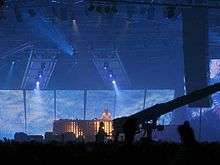LED display

An LED display is a flat panel display, which uses an array of light-emitting diodes as pixels for a video display. Their brightness allows them to be used outdoors in store signs and billboards, and in recent years they have also become commonly used in destination signs on public transport vehicles. LED displays are capable of providing general illumination in addition to visual display, as when used for stage lighting or other decorative (as opposed to informational) purposes.
History
The first true all-LED flat panel television screen was possibly developed, demonstrated and documented by James P. Mitchell in 1977. Initial public recognition came from the Westinghouse Educational Foundation Science Talent Search group, a Science Service organization.[1] The paper entry was named in the "Honors Group" publicized to universities on January 25, 1978.[2] The paper was subsequently invited and presented at the Iowa Academy of Science at the University of Northern Iowa.[3][4] The operational prototype was displayed at the Eastern Iowa SEF[5] on March 18 and obtained a top "Physical Sciences" award and IEEE recognition. The project was again displayed at the 29th International SEF at the Anaheim Ca. Convention Center on May 8–10.[6] The ¼-inch thin miniature flat panel modular prototype, scientific paper, and full screen (tiled LED matrix) schematic with video interface were displayed at this event.[7][8] It received awards by NASA[9] and General Motors Corporation.[10][11][12] This project marked some of the earliest progress towards the replacement of the 70+ year old high-voltage analog CRT system (cathode-ray tube technology) with a digital x-y scanned LED matrix driven with a NTSC television RF video format. Mitchell's paper projected the future replacement of CRTs and included foreseen application to battery operated devices due the advantages of low-power. Displacement of the electromagnetic scan systems included the removal of inductive deflection, electron beam and color convergence circuits and has been a significant achievement. The unique properties of the light emitting diode as an emissive device simplifies matrix scanning complexity and has helped the modern television adapt to digital communications and shrink into its current thin form factor.
The 1977 model was monochromatic by design. The efficient Blue LED completing the color triad, did not arrive for another decade. Large displays now use high-brightness diodes to generate a wide spectrum of colors. It took three decades and organic light-emitting diodes for Sony to introduce an OLED TV, the Sony XEL-1 OLED screen which was marketed in 2009. Later, at CES 2012, Sony presented Crystal LED, a TV with a true LED-display (in which LEDs are used to produce actual images rather than acting as backlighting for other types of display, as in LED-backlit LCDs which are commonly marketed as LED TVs).
The 2011 UEFA Champions League Final match between Manchester United and Barcelona was broadcast live in 3D format in Gothenburg (Sweden), on an EKTA screen. It had a refresh rate of 100 Hz, a diagonal of 7.11 m (23 ft 3.92 in) and a display area of 6.192×3.483 m, and was listed in the Guinness Book of Records as the largest LED 3D TV.[13][14]


See also
References
- ↑ Science Service 1719 N Street N.W. Washington, D.C. 20036 (1978), https://student.societyforscience.org/science-talent-search-through-years.
- ↑ The honors group STS projects were released for publication January 25, 1978 to "all leading universities and colleges of the united States utilizing a list furnished for the American Council on Education".
- ↑ This event was held April 21–22 in Cedar Falls, Iowa at the UNI campus
- ↑ Mitchell's abstract title "Light Emitting Diode Television Screen" was published in the Honors Group of the 37th Annual Science Talent Search for the Westinghouse Science Scholarship and Awards in 1978, this qualified Mitchell for the UNI paper presentation that followed
- ↑ Science and Engineering Fair http://www.eisef.org
- ↑ ISEF winner history http://www.eisef.org/pmwiki/index.php/Web/SeniorChampionsByYear
- ↑ Project was viewed by ISEF judges, Los Angeles area college professors, the 1977 president of the national chapter of the IEEE, and also included a public viewing.
- ↑ The prototype and scientific paper "Light Emitting Diode Television Screen" were part of exhibit #635.
- ↑ 29th ISEF "Announcement of Awards", p. 4, May 13, 1978, published by the Science Service, 1719 N Street Washington D.C. 20036.
- ↑ 3rd Grand GM ISEF award, GM was also the corporate sponsor of the 1978 Science Service event. 1978 29th Annual ISEF "Announcement of Awards", p. 5, (note: Intel Corporation is the current sponsor of this event).
- ↑ Mitchell's modular LED x-y (horizontally and vertically digitally scanned array system) was cited in the 29th International Science and Engineering Exposition "book of abstracts", p. 97, published by the "Science Service", Washington D.C. May 1978.
- ↑ Mitchell continued to display the fully operational prototype including May 6 at the University of Northern Iowa Industrial Arts event capturing another first award. Additional recognition included letters from Iowa senators John Culver and Dick Clark, the Air Force, the Army, college and university letters acknowledging the Westinghouse STS paper entry.
- ↑ EKTA’s Ukrainian produced 3D Led TV makes The Guinness Book of World Records, www.ekta-led.com
- ↑ Largest LED 3D TV. guinnessworldrecords.com
External links
![]() Media related to LED displays at Wikimedia Commons
Media related to LED displays at Wikimedia Commons